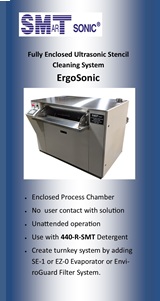| Sponsor |

|
Dedicated Tool for Process Development
Advanced plating capability at Uyemura Tech Center: Process Development, UBM, pilot production. ENIG, ENEPIG, EPIG/EPAG, RAIG immersion gold; all substrates. On-site analysis.
Uyemura
|
|
| Sponsor |

|
SEHO makes production lines smarter
Improve your work flow and reduce manufacturing costs with creative ideas and innovative solutions for automation, board handling and material management.
SEHO Systems GmbH
|
|
| Ask the Experts |
|
|
May 29, 2006 - Updated
July 5, 2007 - Originally Posted
Difference between ENIG and Flash?
With PCB plating what's the difference between ENIG and Flash?
Mike Johnson
|
| Expert Panel Responses |
You are comparing apples to oranges. ENIG describes materials (nickel and gold) and processes (electroless for nickel and immersion for gold). Flash describes the plating thickness. Flash typically means a very thin (3 to 10 microinches) coating of gold, regardless of the process. Therefore, flash gold could be electrolytic, electroless, or immersion. Initial problems with flash gold in the 1990's tend to refer to an electroless process used over separable connectors that resulted in galvanic-driven pore corrosion.
Dr. Craig D. Hillman
CEO & Managing Partner
DfR Solutions
Dr. Hillman's specialties include best practices in Design for Reliability, strategies for transitioning to Pb-free, supplier qualification, passive component technology and printed board failure mechanisms.
|
|
Submit A Comment
|
Comments are reviewed prior to posting. You must include your full name to have your comments posted. We will not post your email address.
|
Free Newsletter Subscription
Circuitnet is built for professionals who bear the responsibility of looking ahead, imagining the future, and preparing for it.
Insert Your Email Address
|
| Sponsor |

|
Epoxy Offers Ultra High Heat Transfer
Bond EP5TC-80 is a NASA low outgassing rated epoxy that achieves a thermal conductivity of 3.3-3.7 W/(m·K), while also retaining its electrical non-conductivity.
Master Bond
|
|
|





